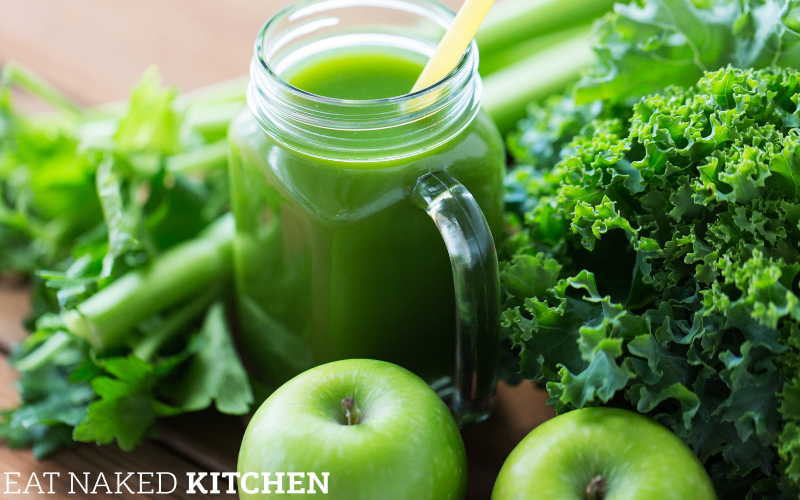Ever had that moment when you order a green juice from your local juice bar and it looks so good and healthy but tastes utterly gnarly? Or, on the flip side, it’s so sickly sweet from all the fruit they’ve added that you know it’s a barely a “green” juice at all. And that doesn’t even touch the crapshoot of my early juicing days at home. Sometimes the juice was the drink of the Gods, other times I could barely get it down.
It doesn’t have to be this way. There is actually a formula for making a really good, consistent green juice exactly to YOUR taste. Because, like with everything, what works for me might not be what works for you. The perfect green juice differs slightly from person to person based on your unique palate. Here are the basics to make approximately 1 quart of green juice. Get out your juicer and let’s play!
Cucumber – Cucumber is the base of the juice. This is what provides a lot of the liquid, and cucumber’s delicate flavor doesn’t overwhelm the rest of the juice. We use 4-6 medium-sized cucumbers. It provides good contrast to some of the stronger-flavored veggies in this juice. From a nutritional perspective, cucumber is a great source of antioxidants and anti-inflammatory compounds, and it is currently the subject of research for potential anti-cancer properties. It’s a great juice for summer, as it is very cooling and hydrating. If we can’t find cucumber, we’ll sometimes use a big head of lettuce in its place.
Kale or another dark leafy green – Dark greens are very cleansing and often have a slightly bitter taste. We add them to our juice, but not in huge quantities. We’ll use 4-6 small kale leaves or 2-3 big ones. Nutritionally, they are an exceptional source of vitamin K1 (but note: this is a fat-soluble vitamin, so you need to have some fat at the same time as your juice to reap the benefits) and they’re jam-packed with antioxidants and anti-inflammatory compounds. While these greens are wonderful and nutrient-rich, if you’ve got thyroid problems you may want to skip them, as they do contain goitrogens which can exacerbate thyroid conditions.
Celery – Celery adds your natural salty flavor to the juice. I normally use about 3-5 stalks. It’s a potent antioxidant and is very anti-inflammatory, in particular for the digestive tract. This makes it very healing for anyone struggling with digestive issues.
Radish – Radishes add some nice spice to your juice. I’ll use between 4-6 radishes in a juice and find this adds a lovely punch to it. You can also juice the greens, which adds a peppery flavor. Delicious! Radishes are a great source of vitamin C, folate, riboflavin and potassium, and have been shown to regulate blood pressure, relieve congestion, and help in the prevention of respiratory problems.
Parsley – Parsley adds a pungent and bold flavor, so go easy! I like to use a small handful. Parsley is a great source of Vitamin K1 and, as with everything else on this list, it’s a potent antioxidant. Being high in vitamin C, it’s been shown to be protective against inflammatory polyarthritis, a type of rheumatoid arthritis involving two or more joints.
Apple – For a little sweetness, here’s your one fruit to satisfy my 4:1 vegetable to fruit ratio. The apple supplies just a touch of sweet without sending your blood sugar soaring. Indeed, apples are currently being studied for their role in blood sugar regulation, which makes them an excellent sweetening option for our green juice. And of course, they’re loaded with antioxidants. I’ll use a 1/2 apple or a full one, depending on how much sweet I’m looking for.
So now you have the basic formula for the perfect green juice. From here you can increase/decrease amounts of any given food/flavor based on your personal preference. A little milder? Less kale and more cucumber. A little saltier? More celery. A little bolder? Increase the amount of radish and parsley you use. A little sweeter? More apple.
Time to get juicing!
And if you’re like me and you can’t fathom throwing out all that veggie fibre, here are 20 creative uses for leftover juice pulp.









I am new to the juice and smoothy making endeavor. But I want to get on board. Can I use a blender for making juice and smoothies? Also, what recommendations do you have for brands and/or models for blenders and/or juicers?
You can use a blender for making smoothies, but not for juicing. The blender will just puree everything – juicers actually juice the veggies/fruit, leaving the fibrous pulp behind. Make sense?
If I wanted to make enough to last a week, would that be possible? Would it last in the fridge that long?
Amanda – juice degrades very quickly so it won’t last a week. At most, I’d say it will last 24-48hrs. If you add a touch of raw honey you will extend its life.
I just got a Vitamix for Mother’s Day today. Does anyone know if you can juice in it?
@Tess – you can’t juice in a Vitamix, but you can make green smoothies. Here’s a recipe for one I use a lot:
By definition, juicing removes the fibre and pulp. Only a juicer will do that. But a Vitamix is a GREAT addition to your kitchen and there is so much you can do with it. What a great Mother’s Day gift!
The green smoothie was a big hit! I made this one as a smoothie, and the one with the whole coconut and avocado. Someone recommended a nut milk bag to strain out the pulp, so I might give it a whirl.
Margaret, I often make a green smoothie (or red if I put raw beet in it) and take it to go as my breakfast. Two questions: (1) How can I make it more of a sustainable meal? Add yogurt or grains/seeds/nuts? How about adding supplements like chia (soaked) or flax (ground)? (2) If you don’t consume foods with fat with it, can you add a tad of oil to make the K1 more bio-available? What do you recommend? I don’t have a juicer, but I do have a Vitamix and that blends it to a completely smooth consistency. Love it.
Hi Jaime – the way to make it a more sustainable meal is to add protein and fat. Good protein sources: a couple of raw eggs from pastured chickens (source and quality are very important here), some full-fat yogurt or kefir, some gelatin (again, quality is important. this is the only one I like and recommend). You can also add soaked nuts, nut butters, soaked seeds as you say. You could also add some fresh coconut meat, which would be delicious.
When you ask about not consuming foods with fat in them – my first question would be: why?? Fat is one of the most important nutrients to our health so I am absolutely not a proponent of a no- or low-fat diet. If you want, you can certainly you can add a good quality oil to make the vitamin K more bio-available.